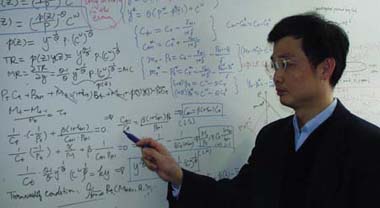| .gif)
Research that adds to the discussion on whether the Hong Kong dollar should be pegged to the Chinese yuan instead of the US dollar has turned up some surprise findings.
With the HK$-US$ peg, Hong Kong in effect is using the same currency as the US because they share the same monetary policy, said Principal Investigator Associate Professor Xinpeng Xu from the School of Accounting and Finance at The Hong Kong Polytechnic University.
 |
| Dr Xu works on his equations on international finance |
The basic precept for successfully pegged currencies is that the business cycles of the respective economies should move together and be closely synchronised, he said. That means boom times and economic “shocks” in the pegged economies should happen at the same time.
“If the economies are not synchronised,” said Dr Xu, “then there are problems.”
An example was the Asian financial crisis of 1998, he said, when Hong Kong was in shock but the US was still enjoying a boom.
Hong Kong needed to loosen monetary policy as in lowering interest rates but, because of the peg, had to follow the US which was tightening its monetary policy to stem inflation.
Dr Xu’s research studied the key economic indicators of GDP growth and inflation in Hong Kong, the US and mainland China from the first quarter of 1988 to the last quarter of 2001 to reveal the extent of synchronisation, and determine if the mainland economy was more in step with Hong Kong’s.
“The results were surprising,” said Dr Xu. “Not only did we find that synchronisation between the US and Hong Kong was low but that there was not much hard evidence to show that Hong Kong is moving more closely to China. This was quite different from the common perception that the China factor has been playing an important role in Hong Kong.”
Other studies on business cycle synchronisation have focused purely on the co-relation of economic indicators in common currency regions. Dr Xu’s research, however, went further by filtering out government responses to the economic shocks.
“The shocks on their own give a more accurate picture,” he explained. During the Asian financial crisis, Hong Kong’s response because of the peg was to follow the US’s boom-time monetary policy resulting in negative growth of about 5 percent.
In China, which was also hit by the crisis, the response was to stimulate the economy which still resulted in 7.8 percent growth.
Dr Xu filtered out the shocks and responses of the business cycles using the latest econometric technique known as a structural VAR (vector auto-regression).
He then gauged the degree of similarity in how the shocks affected the different economies using a state-space model technique.
The surprise in Prof Xu’s research, that the Hong Kong and mainland economies had not been increasingly synchronised up to the end of his research period in 2001, may have developed since 2003, he said, when China relaxed its policy on the flows of people and capital into Hong Kong.
With a greater degree of economic integration should come greater synchronisation, he said, but he forecasts that the right time for a HK$-Yuan peg is a long way off.
He added: “I believe the research is one important step to a good discussion before we can make any informed decision on pegging to the Yuan instead of the US dollar.”
Principal Investigator
Dr Xinpeng Xu : afxxu@inet.polyu.edu.hk
 |
.gif)
